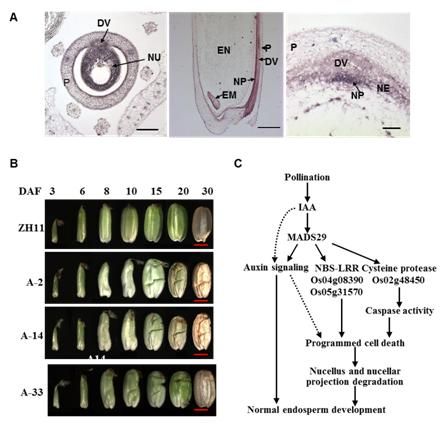Rice seeds are major sources of human food. The seed development depends on a complex regulatory network in which transcription factors are key factors. Studies showed that the rice MADS-box TFs are the most important regulators in floral organs development and most of them express during seed development. However, their functional data in seed development is scarce.
Studies by Prof. XUE Hongwei’s lab at the Institute of Plant Physiology and Ecology (IPPE), Shanghai Institutes for Biological Sciences, CAS showed that MADS29, which is preferentially expressed in reproductive stages identified via Xue lab’s preliminary microarray hybridization studies, is expressed in anther, ovule and seed, especially highly expressed in the maternal tissues after pollination. Suppressed expression of MADS29 results in shrunken seeds, abnormal starch granules and low grain-filling rate. The histological studies, TUNEL assay and microarray analyses proved that MADS29 promotes the programmed cell death (PCD) processes of nucellus and the nucellar projection. Further studies demonstrate that MADS29 regulates the downstream genes by direct binding the promoter regions. These findings identify an upstream regulator of the degradation of the nucellus and the nucellar projection, and prove the crucial role of the degradation in grain-filling. In addition, IAA may regulate the maternal tissue degradation and endosperm development, providing informative clues for the molecular mechanism of seed development.
This research entitled “The MADS29 regulates the degradation of the nucellus and the nucellar projection during rice seed development” was published in Plant Cell in March 2012.

(A) Spatial and temporal expression analyses of MADS29 by RNA in situ hybridization.
(B) Rice plants with suppressed MADS29 expression show abnormal seed development.
(C) Hypothetical model of MADS29 function in seed development.
(Picture provided by XUE Hongwei's lab)
(IPPE)

